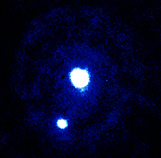





Pluto orbits the Sun at a distance greater than any other planet for most of the time. Conditions here are extremely cold and at first glance Pluto seems to be a lifeless place, frozen to the core and still. This is unlikely to be the case, however, for Pluto has a companion - Charon - which is smaller and somewhat different in composition and behavior. Though small, both these bodies must undergo tidal heating to some extent and this will provide sub-surface heat. Additionally although Pluto is a long way from the Sun, some radiation does reach it in the same way that heat reaches Triton. In fact at times Pluto is nearer to the Sun than Triton, because of its elliptical orbit. This is the case at present, Pluto will remain inside the orbit of Neptune until 2004.
Pluto has been observed and mapped at coarse resolution by the Hubble Space Telescope. It displays areas of light and dark and is superficially similar in appearance to the moons of the Ice Giants Uranus and Neptune. It is almost certainly made of the same materials as Miranda and Triton. If enough heat reaches Triton to power its cold volcanism, then the same must be true of Pluto during its aphelion phase (when it is closest to the Sun).
The Hubble Space Telescope will take more images of Pluto and we may see a variation in the landscape, through seasonal changes in exotic snowfall and cold volcanic flows. But what are the prospects for life on Pluto, and Charon, for that matter? Although tidal forces are causing internal heating, Pluto and Charon are unlikely to offer good habitats for life even below the snows and frozen crust.
Pluto is the only planet we have not visited with a robot explorer, and most of what we think we know about it is from deduction. One thing is certain, when we do get there it will yield up as many surprises as the other planets and moons have done.
Pluto
Charon
Pluto's moon
Charon is covered with crystalline water and ammonia Ice
Observations
Show Frigid Charon Has Had Some Hot Times
© All images NASA
Go
to
Home
| Space Station
| Mars | Rainforest
© 1999 Satellite Events Enterprises Inc.